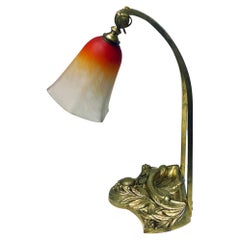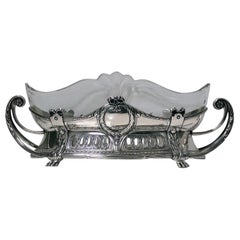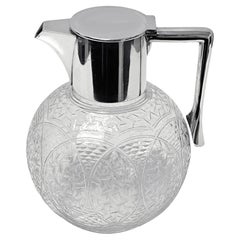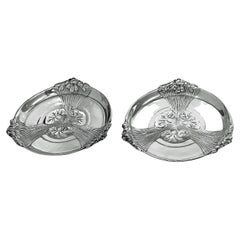Want more images or videos?
Request additional images or videos from the seller
1 of 7
Quezal Glass Desk Lamp, circa 1910
$3,850List Price
About the Item
- Creator:Quezal (Manufacturer)
- Dimensions:Height: 15 in (38.1 cm)Width: 10 in (25.4 cm)Depth: 4.75 in (12.07 cm)
- Style:Art Nouveau (In the Style Of)
- Materials and Techniques:
- Place of Origin:
- Period:
- Date of Manufacture:circa 1910
- Condition:
- Seller Location:Toronto, CA
- Reference Number:Seller: L11321stDibs: LU107063004832
About the Seller
5.0
Recognized Seller
These prestigious sellers are industry leaders and represent the highest echelon for item quality and design.
Established in 1880
1stDibs seller since 2014
147 sales on 1stDibs
Authenticity Guarantee
In the unlikely event there’s an issue with an item’s authenticity, contact us within 1 year for a full refund. DetailsMoney-Back Guarantee
If your item is not as described, is damaged in transit, or does not arrive, contact us within 7 days for a full refund. Details24-Hour Cancellation
You have a 24-hour grace period in which to reconsider your purchase, with no questions asked.Vetted Professional Sellers
Our world-class sellers must adhere to strict standards for service and quality, maintaining the integrity of our listings.Price-Match Guarantee
If you find that a seller listed the same item for a lower price elsewhere, we’ll match it.Trusted Global Delivery
Our best-in-class carrier network provides specialized shipping options worldwide, including custom delivery.You May Also Like
Quezal Art Nouveau Lamp
By Quezal
Located in NANTES, FR
Art nouveau lamp circa 1910.
Brass and copper base.
Iridescent glass tulip signed Quezal.
In perfect condition and electrified.
Total height: 38.5 cm
Base diameter: 15.5 cm
Width: 30 cm
Quezal Art Glass
Quezal Art Glass – The Journal of Antiques and Collectibles – April 2003
By Malcolm Mac Neil
Some of the most beautiful and alluring art glass made in America during the early part of the 20th Century was made by the Quezal Art Glass and Decorating Company. Often in the shape of blossoming lilies with brilliant gold interiors and colorfully decorated with floral and other motifs inspired by nature, Quezal art glass ranks right alongside the iridescent glass of Louis Comfort Tiffany and Frederick Carder. Quezal artisans created an extensive range of decorative and useful items, including vases, compotes, finger bowls, open salts, candle holders, and shades for lighting fixtures, which are equivalent in terms of beauty and quality of craftsmanship to Tiffany’s Favrile and Carder’s Aurene glass. In recent years, glass collectors have discovered anew the special charms and appeal of Quezal art glass, and collector desirability for this lovely glassware has increased dramatically.
The Quezal Art Glass and Decorating Company was incorporated a century ago, on March 27, 1902. It was founded by Martin Bach, Sr., Thomas Johnson, Nicholas Bach, Lena Scholtz, and Adolph Demuth. The factory was located on the corner of Fresh Pond Road and Metropolitan Avenue in Maspeth, Queens, New York. In October 1902, the trademark “Quezal” was successfully registered. By 1904, roughly fifty glassworkers were employed at the works.
Martin Bach, Sr. was the president, proprietor, and guiding force behind this successful company. Born in 1862 in Alsace-Lorraine to German parents, he emigrated to the United States in 1891. Before his emigration, Bach worked in Saint-Louis, France, at the Saint-Louis Glass Factory. After Bach arrived in this country, he was hired by Louis C. Tiffany as the latter’s first batch-mixer or chemist at the newly established Tiffany Glass and Decorating Company, in Corona, Queens. After a period of about eight years, Bach left Tiffany and established his own glassworks. By this time, Bach had already started his small family. He and his German-born wife, Anne-Marie Geisser, whom he married in the fall of 1889, in Paris, France, had three children. Two daughters, Jennie and Louise, were born in France and a son, Martin, Jr., was born in Corona.
Bach was assisted by Thomas Johnson, an English immigrant, and Maurice Kelly, a native of Corona, both of whom were gaffers or master glassblowers. Johnson and Kelly helped pave the way for Quezal’s early accomplishments and later recognition. Thomas Johnson, like Bach, was a founding member and also previously employed by Louis C. Tiffany. Johnson’s association with Quezal, however, was relatively short lived. Around 1907, Johnson left for Somerville, Massachusetts, where he became involved in making Kew Blas glass, under William S. Blake at the Union Glass Company. Maurice Kelly’s tenure with Quezal was also brief. Kelly worked at Quezal from January 1902 until July 1904, but by November 1904, he was making Favrile glass at Tiffany Furnaces, where he would happily remain until 1918.
To this day, the belief still exists that there once existed a man named Quezal, who worked for Louis C. Tiffany, and it is after him that Quezal glass is named. In truth, however, the founders of the Quezal Art Glass and Decorating Company named the company and its products after one of the world’s most beautiful birds, the elusive and rare quetzal, which dwells in the treetops of the remote tropical forests of Central America. A rare company promotional brochure provides a vivid description of the quetzal: Of all the birds of the America’s, it is the most gorgeous. No more splendid sight is to be seen in all the world than a quezal, flying like a darting flame through the depths of a Central American forest. Its back is of a brilliant metallic green, so vivid it shines even in the twilight of the woods like a great emerald and its breast is a crimson so deep and bright that every motion of the wonderful creature is a flashing of rubies among the trees and giant creepers. It bears a true golden crown upon its head – a helmet of bright yellow and green, shaped just as the helmet of old Aztec kings were shaped. Its tail is composed of lacelike plumes, extending more than two and one-half feet beyond its body.
The quezal was certainly an appropriate designation for the company’s resplendent glassware. One of the most prized characteristics of Quezal art glass is the shimmering and dazzling brilliance reflected in the iridescent surfaces on the interior as well as exterior of the glass. The radiant rainbow colors in metallic hues, including gold, purple, blue, green, and pink, to name only a few, were certainly inspired by the quetzal and its feathers. Not surprisingly, lustrous feathers, in shades of opal, gold, emerald, and blue, are among the most common decorative motifs encountered on Quezal glass.
The enduring hallmark of Quezal art glass is its unique expression of the Art Nouveau style, based on organic shapes and naturalistic motifs coupled with technical perfection in the execution. Vases, compotes, drinking vessels, and shades for lighting fixtures were often fashioned to resemble flowers such as crocuses, tulips, calla lilies, casablanca lilies, and jack-in-the-pulpits. Variously colored inlaid threads of glass, pulled and twisted by hooks, simulate naturalistic floral and leaf patterns, lily pads, clover leafs, and vines. Opal, gold, and green colors prevail and the glass is generally opaque. Red is the rarest color of all. Compared with Tiffany’s Favrile glass, the crisp, vivid, and colorful decoration of Quezal art glass is distinctively precise, symmetrical, and restrained.
Other Quezal wares recall shapes and styles favored in ancient Egypt, Persia, Greece, and Rome, as well as the Italian Renaissance and the Georgian period in England. This is especially true of classic-shaped vases and bowls of translucent amber glass, which have a single surface color such as iridescent gold or blue. Still, others were inspired by traditional Chinese and Japanese forms.
The Gorham Manufacturing Company in Providence, Rhode Island, and the Alvin Silver Manufacturing Company in Sag Harbor, Long Island, purchased Quezal art glass, which they in turn embellished in their shops with silver overlay decoration in the fashionable Art Nouveau style and later resold. Gorham’s silver overlay designs mostly include stylized floral motifs. Alvin’s silver designs are wonderfully organic. One sumptuous design is of a group of sinuous iris blossoms with carefully articulated petals surrounded by attenuated meandering vines. Collectors should note that not all silver-deposit pieces are marked with a maker’s mark since the silversmith had to be quite careful not to damage the glass underneath.
A rare 1907 retail catalog survives from Bailey, Banks, and Biddle Company, a luxury goods retailer in Philadelphia, which reveals original retail prices of Quezal art glass. A surprising revelation provided by this catalog is that Quezal art glass was nearly twice as expensive as comparable French imported glass made by such renowned firms as Gallé and Daum. Hock glasses, a stemmed glass used primarily for drinking German white wine, were sold by the dozen and retailed between $50 and $75. Fingerbowls were also sold by the dozen and retailed between $50 and $100. These high retail prices were nearly the same as those charged for Tiffany’s Favrile glass, and suggest Quezal art glass was also marketed towards the high-end or luxury market.
Electricity was a brand new invention in the late 1800s and American glass manufacturers developed novel approaches for concealing the electric light bulb, which was rather harsh to the eye and perhaps unflattering to the domestic interior. Tiffany, Steuben, and Quezal responded to this need with the most extraordinary and beautiful art-glass shades, all of which were hand-made and exquisitely fashioned. Many other companies also made art glass shades for table and floor lamps, electroliers, hallway fixtures, and wall sconces, but it was Quezal that excelled in this area and was the most prolific.
Quezal art glass shades were available in an infinite variety of shapes, sizes, colors, and decorations. Some shades are formed and decorated as lilies while others are bell-shaped and have ribbed or textured decoration. Rims are usually plain but sometimes are notched or ruffled. Common motifs include feather or hooked feather, leaf and vine, applied flowers, drape, fishnet, King Tut, and spider webbing. The workmanship shown on most Quezal shades...
Category
Vintage 1910s French Art Nouveau Table Lamps
Materials
Brass, Copper
1910 Art Nouveau P. Rigual Lily Pad Motif Boudoir Lamp, 13" high, Quezal Shade
By P. Rigual, Quezal
Located in Toledo, OH
This turn of the century art nouveau boudoir lamp by P. Rigual is fitted with a Quezal shade. The bell form iridescent glass shade has gold thr...
Category
Vintage 1910s Art Nouveau Table Lamps
Materials
Art Glass
$2,000
H 13 in W 7.5 in D 4.5 in
Art Deco Brass Desk Lamp With Quezal Favrile Art Glass Shade
By Tiffany Studios
Located in South Bend, IN
A gorgeous vintage Art Deco or Art Nouveau desk lamp or table lamp
In the manner of Tiffany Studios
USA, 20th Century
Brass base, with beautiful Favrile art glass shade signed Qu...
Category
20th Century American Art Deco Table Lamps
Materials
Brass
Tiffany Studios Style Antique Art Nouveau Desk Lamp With Quezal Art Glass Shade
By Tiffany Studios
Located in South Bend, IN
A gorgeous antique Art Deco or Art Nouveau period desk lamp or table lamp
In the manner of Tiffany Studios
USA, Circa 1930s
Cast iron base, with brass stem, and beautiful Favrile ...
Category
Vintage 1930s American Art Nouveau Table Lamps
Materials
Brass
$2,395
H 16 in W 5.5 in D 10.5 in
Jugendstil Table Lamp with Opaline Glass, circa 1910s
Located in Wien, AT
Jugendstil table lamp with opaline glass, circa 1910s
Polished and stove enameled.
Category
Vintage 1910s Austrian Jugendstil Table Lamps
Materials
Brass
Quezal Art Glass Fixtures (3)
By Quezal
Located in Bronx, NY
This interesting group of three vintage bronze flush mount ceiling fixtures dates from the 1920’s. Each sculptured bronze fixture features stylish decoration & holds a beautiful bell...
Category
Vintage 1920s American Art Deco Chandeliers and Pendants
Materials
Bronze
Antique Chase Art Deco Brass Desk Lamp With Quezal Favrile Art Glass Shade
By Tiffany Studios, Chase Brass and Copper Company
Located in South Bend, IN
A gorgeous Arts & Crafts or Art Deco period desk lamp
In the manner of Tiffany Studios
Base is by Chase and art glass shade is by Quezal. Both are signed.
USA, Circa 1930s
Brass ...
Category
Vintage 1930s American Arts and Crafts Table Lamps
Materials
Brass
$1,595
H 14 in W 9 in D 6.63 in
Müller Frères, Lunéville, "Anémones" Art Nouveau Glass Lamp circa 1910
By Muller Fres Luneville
Located in Saint-Ouen, FR
Muller Frères, Lunéville, “Anémones” Lamp
Mushroom lamp in multi-layered glass with acid-etched and wheel-carved decoration of red and mauve magnolias in ...
Category
Vintage 1910s French Art Nouveau Table Lamps
Materials
Wrought Iron
$13,848 Sale Price
27% Off
H 21.66 in Dm 11.03 in
Art Nouveau lamp circa 1910
Located in NANTES, FR
Beautiful Art Nouveau lamp, circa 1910.
Brown-veined alabaster shell.
The base is bronze with floral decoration.
Electric and in perfect condition.
Total Height: 52 cm
Shell Diamete...
Category
Vintage 1910s French Art Nouveau Table Lamps
Materials
Alabaster, Bronze
Antique French Art Nouveau Glass Iron Table Desk Lamp Muller Freres 1910
By Muller Frères, G.V. de Croismarre
Located in Portland, OR
A very good antique French Art Nouveau Glass & iron desk table lamp, by Muller Freres, circa 1910.
This is a very elegant "Pate de Verre" lamp made and designed by Muller Freres and ...
Category
Vintage 1910s French Art Nouveau Table Lamps
Materials
Iron
$1,225
H 14.25 in W 13 in D 5.25 in
More From This Seller
View AllFrench Art Nouveau Desk Table Lamp by Charles Schneider, C. 1920
By Charles Schneider
Located in Toronto, Ontario
French Art Nouveau desk table lamp by Charles Schneider (Epinay-sur-Seine, Paris), France, C.1920 on stylised bronze base. The base also with concealed opening for an inkwell. The glass shade was made of blown double glass. Measures approximately 14.00 x 8.00 x 6.00 inches. Lamp shade, white, orange, and amber yellow. Signed Schneider on the shade (difficult to photograph see photos), also with signed base for probably the foundry. The Schneider Glassworks, established by brothers Charles and Ernest Schneider in Epinay-sur-Seine, France, in 1917. Very small chip to top shade fitting, see last photograph. The Schneider Glassworks, established by brothers Charles and Ernest Schneider in Epinay-sur-Seine, France, in 1917, was among the leading producers of fine-art glass between the two world wars, creating exuberantly colorful vessels...
Category
Early 20th Century French Art Nouveau Table Lamps
Materials
Bronze
WMF Art Nouveau Flower Fruit Centrepiece, circa 1910
By WMF Württembergische Metallwarenfabrik
Located in Toronto, Ontario
WMF centrepiece with Art Nouveau floral decoration and the original clear glass liner and silver plate. The Dish on acanthus foliate supports, curvilin...
Category
Early 20th Century German Art Nouveau Planters, Cachepots and Jardinières
Materials
Silver Plate
$1,480 Sale Price
20% Off
Antique English Sterling Silver and Glass Claret Jug John Grinsell 1910
By John Grinsell & Sons
Located in Toronto, Ontario
Antique English Sterling Silver and Glass Claret Jug John Grinsell & Sons, Birmingham 1910. Bulbous form with beautifully cut crystal and engraved glass design. Condition: Good. Glas...
Category
Early 20th Century English Pitchers
Materials
Sterling Silver
$1,480 Sale Price
20% Off
Pair of Christofle Art Nouveau Wine Bottle Holders Coasters C. 1910
By Christofle
Located in Toronto, Ontario
Pair of Christofle Art Nouveau Wine Bottle Holders Coasters C.1910. Stylised Art Nouveau silver plate coasters in remarkable condition for the a...
Category
Early 20th Century French Art Nouveau Barware
Materials
Silver Plate
$800 Sale Price
20% Off
WMF Large Pewter Oval Photograph Frame C.1910
By WMF Württembergische Metallwarenfabrik
Located in Toronto, Ontario
WMF large pewter oval photograph frame C.1910. Relief decorated with a band of roses within a border of overlapping leaves, WMF marks to reverse and B O/X ...
Category
Antique Early 1900s Picture Frames
Materials
Pewter
$875 Sale Price
27% Off
Antique Silver Card Case, Birmingham 1910, Adie and Lovekin
Located in Toronto, Ontario
Antique silver card case, Birmingham 1910, Adie and Lovekin. The card case in the form of a purse with chain attached and ring finger loop. Ri...
Category
Vintage 1910s English Decorative Boxes
Materials
Sterling Silver
$440 Sale Price
20% Off



